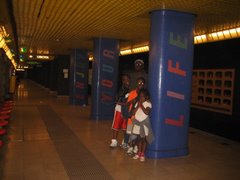
Clara: having pasta and pizza. My favorite kind of pasta is spaghetti with cheese sauce and pizza margarita (it means cheese and tomato sauce pizza).
Elan: getting to know a lot about soccer, getting to know people from around the world, and learning about Roman and Italian culture. It was cool to learn that ancient Romans took over a lot of Europe.

Theo: soccer and Italian food. Soccer is intense, passionate, and fast paced here. Everyone gives their all. My favorite food is pizza: margarita pizza, pizza bianca, and anchovy.
Worst part of living in Rome...

Clara: bullies. There are a lot in first grade. They lie, mostly, and they twist people's wrists.
Elan: aggressive drivers. They annoy my mother, and it's annoying to hear her scream all the time.
Theo: soccer because it's so intense that people get mad if you mess up. The uniforms at school also are bad.













